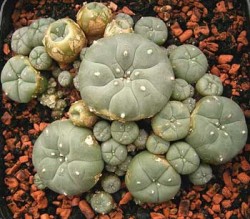Commonly Abused Hallucinogens
As many as 1.1 million Americans reported using hallucinogens for the first time in 2007, according to the National Survey on Drug Use and Health. While hallucinogens come from a variety of sources and take many different forms, these drugs all tend to produce the same types of effects.
Much like their name implies, hallucinogens cause a person to experience hallucinations. Hallucinations can be visual, auditory and tactile in nature. In effect, these chemical agents distort a person’s sense of reality in a big way.
While LSD remains the most popular of hallucinogen drugs, mushrooms, peyote, PMA and 2 C-B, most of which are derived from plant life make up the rest of the list of most commonly abused hallucinogens.
LSD

Peyote is one of the more commonly abused hallucinogenic drugs.
Of all hallucinogen drugs, LSD is the most potent delivering “high” effects that last anywhere from six to 12 hours, according to the University of Memphis. The blotter sheet, a quarter-inch square piece of paper soaked in LSD solution is the most commonly used form of LSD. Hallucinations produced by LSD cause a distortion in shapes and movements as well as slowing down the passage of time.
LSD can produce “good” trips and/or “bad” trips. Good trips entail mentally stimulating sensations and a perceived sense of heightened awareness and understanding. Bad trips consist of extreme feelings of fear involving death, loss of sanity and morbid, terrifying thoughts.
Mushrooms
Also known as “cubes,” “magic mushrooms” and “shrooms,” mushrooms are typically ingested as is ranging from one to five grams in size. Effects from mushrooms can last anywhere from four to six hours with ongoing residual effects lasting for up to two to six hours longer. People may experience any number of psychological impressions from mushrooms, some of which include:
- Paranoia
- Confusion
- Visions
- Perceived insights
- Hallucinations
Peyote
Peyote sits atop the peyote cactus plant in button-like forms. This hallucinogen can be eaten as is, made into a tea as well as powdered and put in capsule form. The effects from peyote include vivid hallucinations, anxiety and time lapses that last up to 12 hours at a time.
Mescaline a natural peyote ingredient produces the drug’s hallucinogenic effects. While hallucinogens carry a low risk for addiction in general, the mescaline ingredient in peyote can be habit-forming. When ingested in large doses, adverse effects, such as nausea and labored breathing rhythms are likely. As hallucinogens often contain impure ingredients, any one dose can cause adverse effects to occur.
PMA
Along with the usual hallucinogenic effects, PMA – also known as paramethoxyamphetamine – carries stimulant properties similar to ecstasy. As a synthetic-type drug, PMA powder can be taken orally in pill form, inhaled or injected.
PMA speeds up central nervous system functions, such as heart rate, respiration rates and increased body temperatures. Adverse effects from PMA resemble those of other stimulant drugs where the risk of heart attack, stroke and/or respiratory distress is always possible.
2 C-B
2 C-B –also known as 4-bromo-2, 5-dimethoxyhenethylamine – closely resembles LSD in its hallucinogenic effects. With this drug, hallucinations tend to be more body-focused in terms of tactile sensations, sensuality and the perception of being “in-the-body” as opposed to the “out-of-body” experience. Vivid visual hallucinations are also common.
Adverse effects from 2 C-B may produce stomach cramps, allergic reactions and distressing thoughts and visions.
- Related Articles
 Examples of Hallucinogens -
Hallucinogens are a class of drugs known for causing psychedelic effects, some of which being unpleasant and even dangerous.
Examples of Hallucinogens -
Hallucinogens are a class of drugs known for causing psychedelic effects, some of which being unpleasant and even dangerous.  Types of Hallucinogens and their Effects -
Hallucinogenic drugs are found in a few different forms, some natural and some man-made. These drugs all have powerful sensory-distorting effects.
Types of Hallucinogens and their Effects -
Hallucinogenic drugs are found in a few different forms, some natural and some man-made. These drugs all have powerful sensory-distorting effects.  Street Names for Hallucinogens -
Find out different ways of referring to various hallucinogens.
Street Names for Hallucinogens -
Find out different ways of referring to various hallucinogens.  Things that Cause Hallucinations that you Need to Worry About Taking -
Some hallucinogens can cause much more than just a psychological addiction. Learn about them here.
Things that Cause Hallucinations that you Need to Worry About Taking -
Some hallucinogens can cause much more than just a psychological addiction. Learn about them here.  What Are Some Examples of Hallucinogenic Drugs (And Why Should I Avoid Them)? -
The effects of hallucinogenic drugs range from mild to severe, making the abuse of these substances a risky behavior.
What Are Some Examples of Hallucinogenic Drugs (And Why Should I Avoid Them)? -
The effects of hallucinogenic drugs range from mild to severe, making the abuse of these substances a risky behavior.